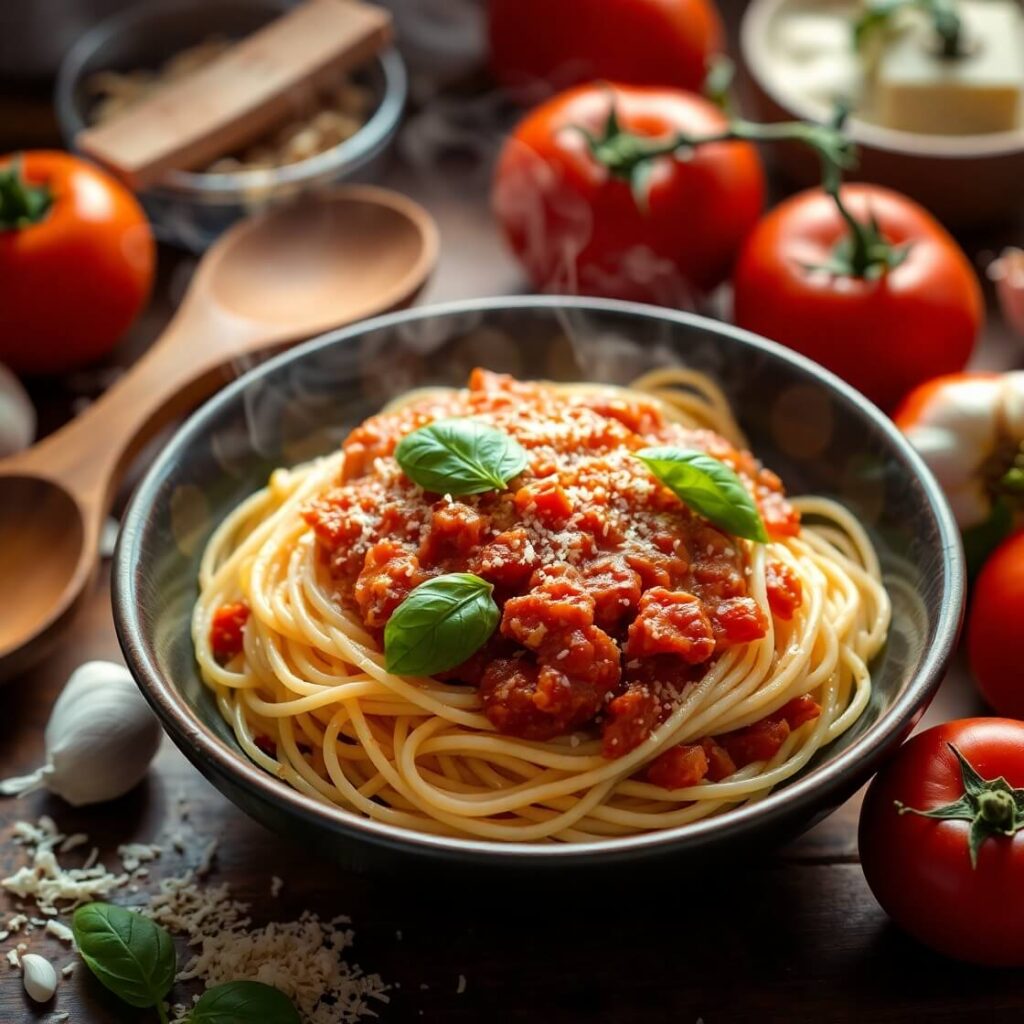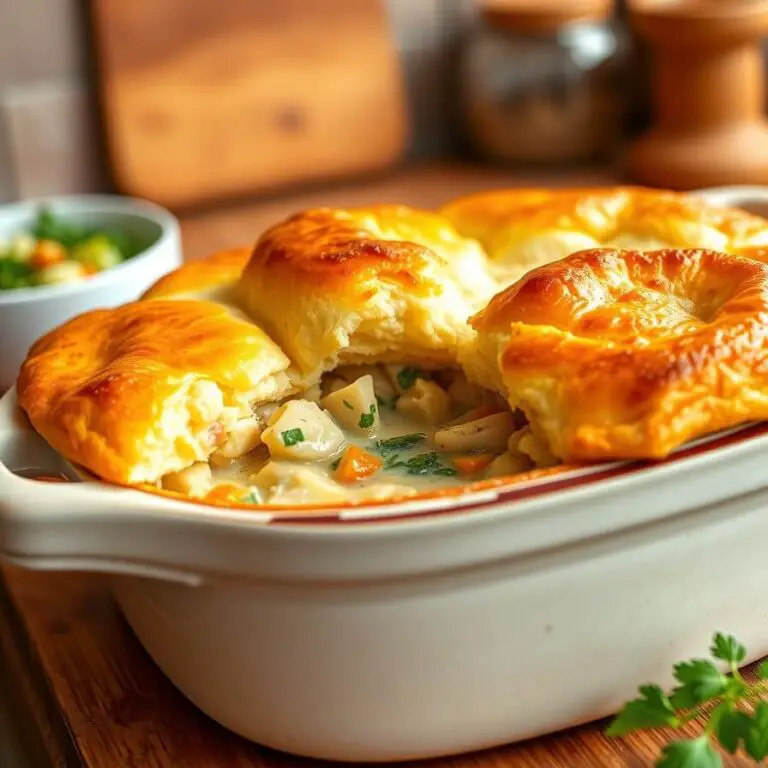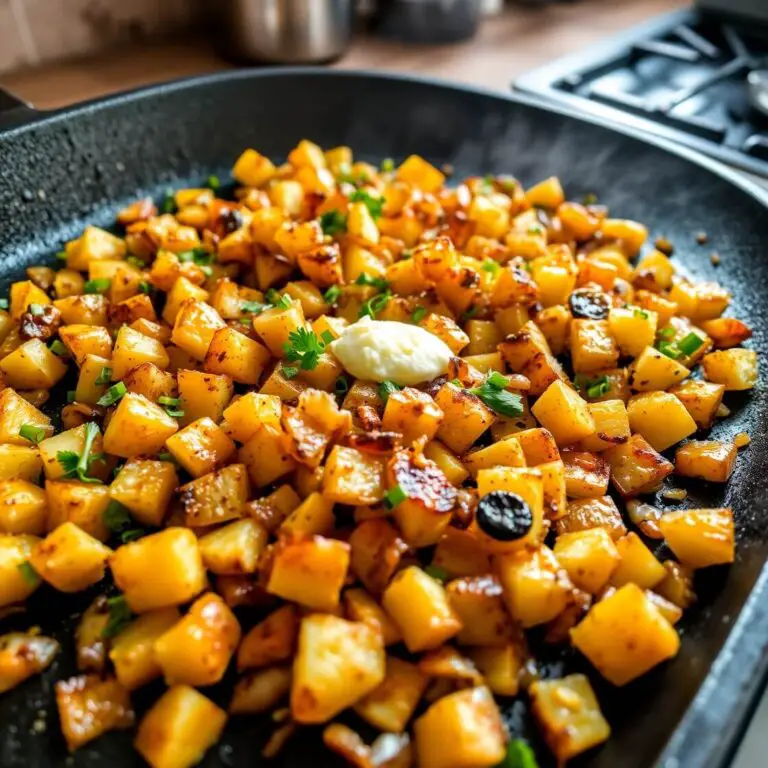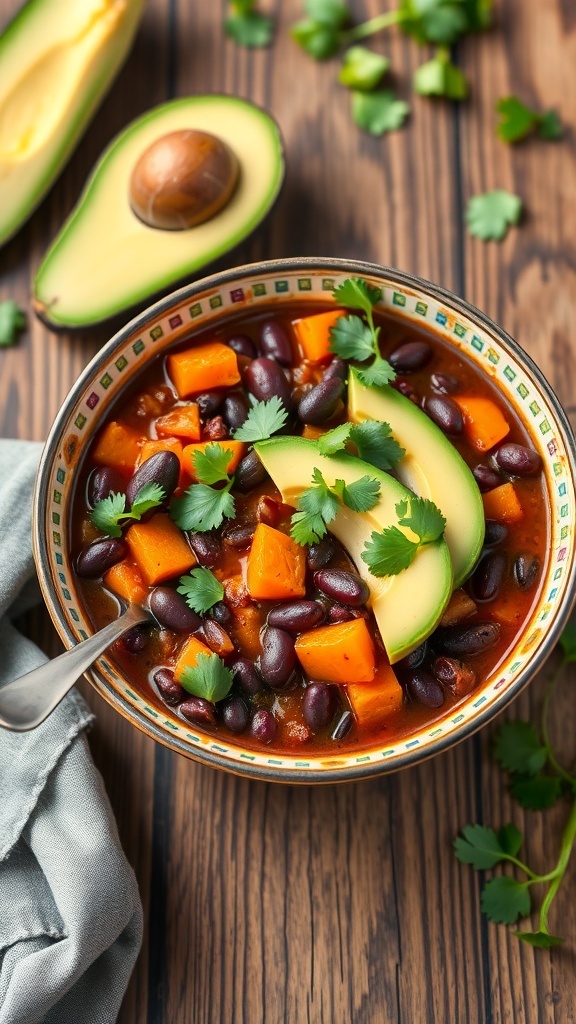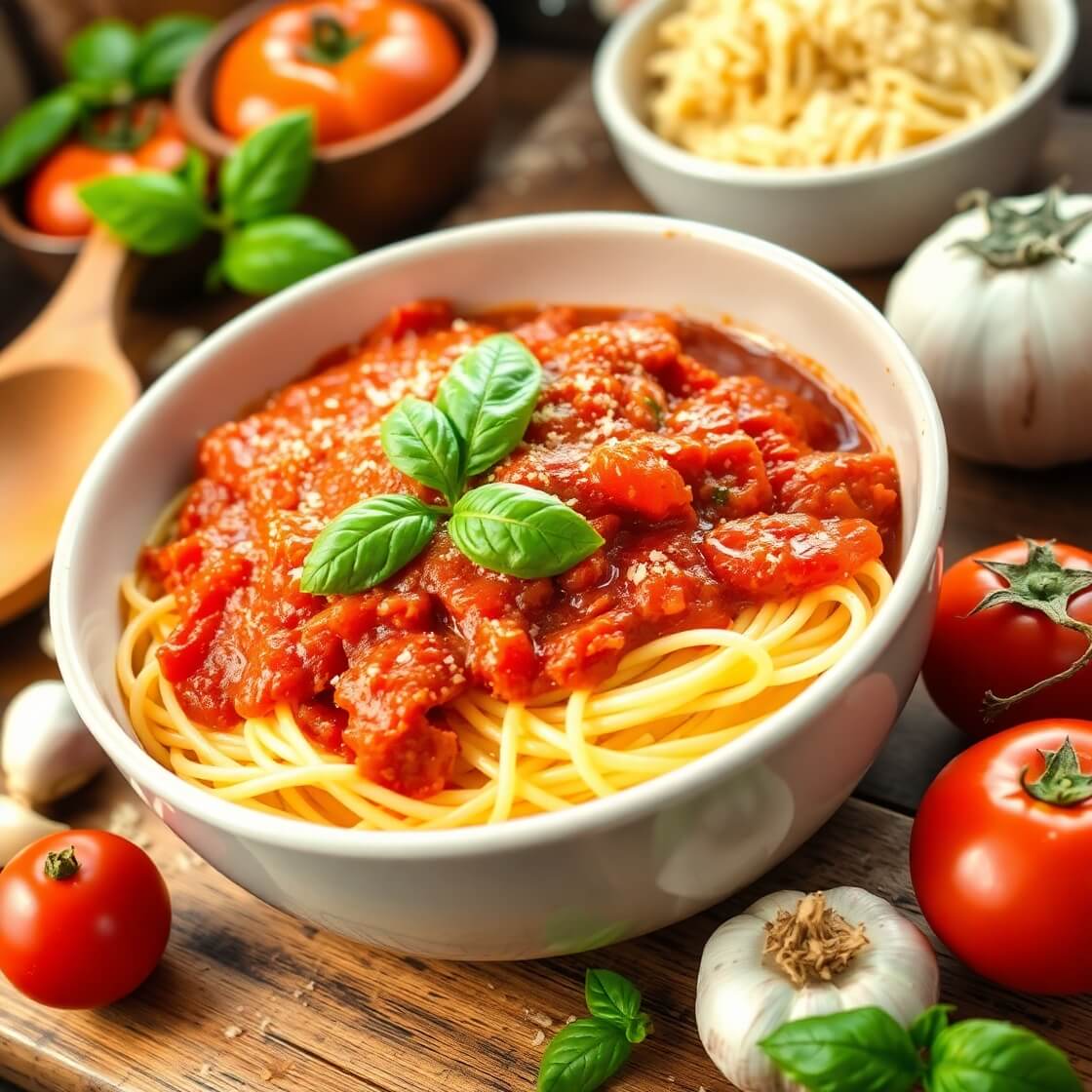
There’s something truly special about homemade spaghetti sauce that instantly transports you to cozy family dinners and nostalgic Sunday afternoons. I created this recipe because I wanted a sauce that feels like a warm hug — rich, flavorful, and made with love from scratch. Whether you’re a busy parent, a novice cook, or just someone who craves that authentic Italian taste without the preservatives or excess sugar found in store-bought jars, this recipe is here to become your go-to.
Making spaghetti sauce at home isn’t just about the end result; it’s about enjoying the process. The aroma filling your kitchen, the slow simmering of tomatoes and herbs — it all adds up to an experience that makes any pasta dish feel gourmet. Keep reading, and I promise you’ll discover how easy it is to whip up a sauce that’s bursting with fresh, vibrant flavors. You’ll never look at jarred sauce the same way again!
Why I Love This Recipe
What makes this homemade spaghetti sauce stand out isn’t just its deep, savory flavor — it’s the way it brings simple ingredients together to create something truly comforting. I love this recipe because it strikes the perfect balance between rich tomato tanginess and aromatic herbs, without feeling heavy or overly sweet.
Many people shy away from making sauce at home because they think it’s complicated or time-consuming. But I’m here to tell you this recipe is designed with ease and flexibility in mind. You don’t need dozens of exotic ingredients or hours of stirring. Instead, this sauce is about quality basics, slow simmering to build flavor, and a few clever tricks to elevate the taste.
It’s a sauce that’s versatile too — perfect for spaghetti, lasagna, meatballs, or even as a base for pizza. And since you control the ingredients, you can tailor it to your dietary preferences or family tastes. From the first bite, you’ll notice the difference fresh herbs and real tomatoes make. It’s wholesome, hearty, and endlessly satisfying.
Ingredients for Homemade Spaghetti Sauce
When it comes to the ingredients, this recipe relies on fresh, pantry-friendly items that combine to create a robust sauce. You’ll need ripe canned tomatoes — San Marzano if you can find them — which are naturally sweet and less acidic. Fresh garlic and onions build a savory foundation, while dried Italian herbs like basil, oregano, and thyme add that classic Mediterranean flair.
Olive oil is essential for that smooth, velvety mouthfeel and a hint of fruity richness. I also include a pinch of sugar to balance the acidity naturally present in tomatoes, but if you prefer, you can skip it or substitute with a natural sweetener like honey or maple syrup. A splash of red wine or balsamic vinegar gives a subtle depth, though it’s optional.
Fresh basil leaves stirred in at the end brighten up the sauce, adding a fragrant finish. Salt and freshly cracked black pepper season the sauce perfectly, and if you want a little kick, a dash of red pepper flakes is a nice touch.
This combination creates a sauce that tastes like it’s been simmering all day, even if it’s ready in under an hour.
How Much Time Will You Need
Making homemade spaghetti sauce is surprisingly quick compared to many other slow-cooked sauces. You’re looking at about 10-15 minutes of active prep time — chopping, sautéing, and stirring — followed by 30 to 45 minutes of simmering to let the flavors meld beautifully.
This balance means you can prepare the sauce on a weeknight after work, or spend a leisurely afternoon making a batch to store for the week. And if you’re in a real hurry, the flavors still come together well even with a shorter simmer.
The time invested truly rewards you with a sauce that tastes fresh, vibrant, and free from artificial additives.
How to Make This Homemade Spaghetti Sauce
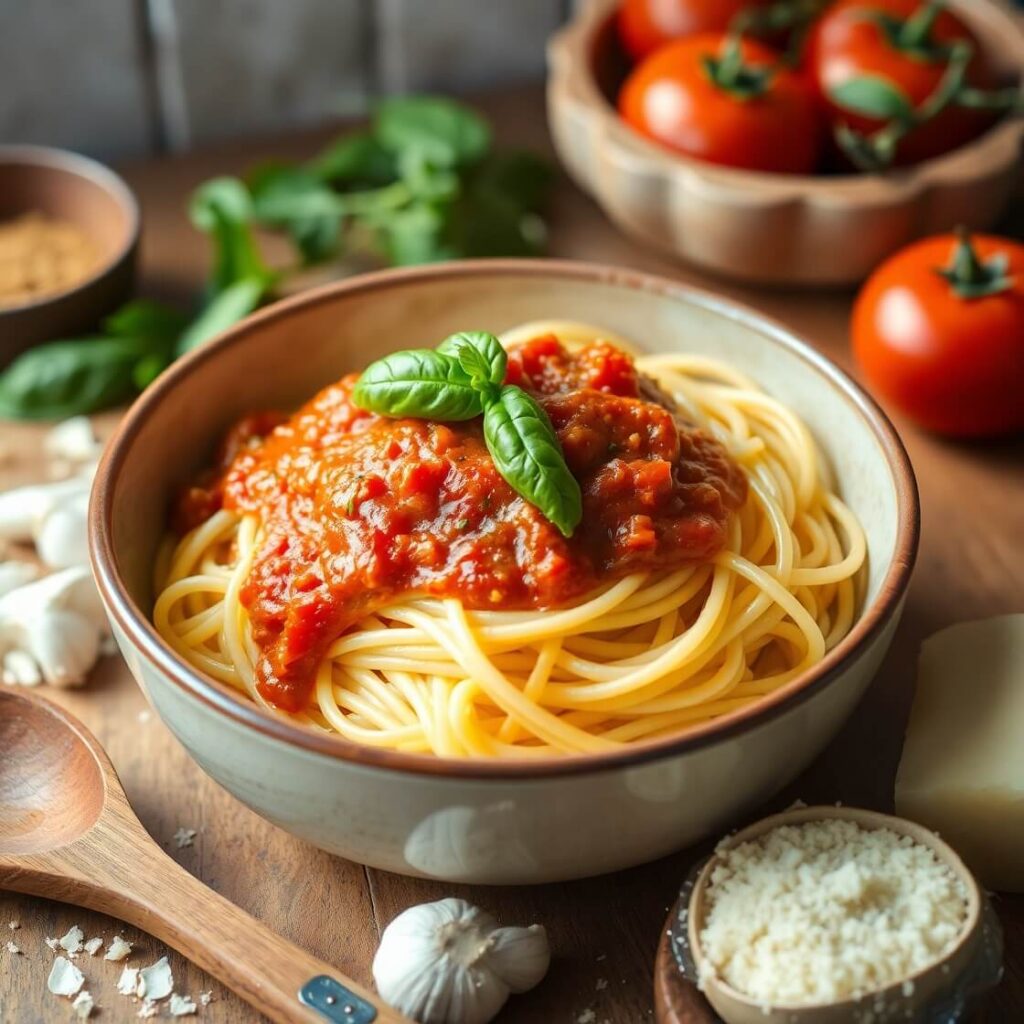
Step – 1: Gather all your ingredients and prepare the vegetables. Finely chop one medium onion and mince three to four garlic cloves. Open a 28-ounce can of whole peeled San Marzano tomatoes and set aside.
Step – 2: Heat about two tablespoons of extra virgin olive oil in a large saucepan over medium heat. Once hot, add the chopped onions and sauté for about 5 minutes until they become translucent and soft but not browned.
Step – 3: Add the minced garlic to the pan and cook for an additional 1 to 2 minutes, stirring frequently, until fragrant. Be careful not to burn the garlic as it can turn bitter.
Step – 4: Carefully add the canned tomatoes, crushing them gently with your hands or a wooden spoon to break them up. Stir everything together to combine.
Step – 5: Add one teaspoon each of dried basil, oregano, and thyme. Season with a pinch of salt and a few grinds of black pepper. If you like a hint of sweetness, sprinkle in about one teaspoon of sugar or your preferred natural sweetener.
Step – 6: (Optional) Pour in about ¼ cup of red wine or balsamic vinegar to deepen the flavor profile. Stir well.
Step – 7: Bring the sauce to a gentle simmer, then reduce the heat to low. Cover partially with a lid to allow steam to escape and let it simmer gently for 30 to 45 minutes, stirring occasionally to prevent sticking.
Step – 8: Towards the end of cooking, taste the sauce and adjust seasoning as needed. If it’s too acidic, a small pinch more sugar can balance it out. Tear a handful of fresh basil leaves and stir them in just before serving to keep their bright, herbal aroma intact.
Step – 9: Once the sauce has thickened and flavors have melded, remove from heat. Serve immediately with your favorite pasta, or cool and store for later use.
Substitutions
If you’re looking to tweak this recipe or accommodate dietary preferences, several substitutions can keep the sauce delicious without compromising flavor.
Instead of canned whole tomatoes, you can use crushed tomatoes or tomato puree for a smoother texture. For a chunkier sauce, diced tomatoes work well too. If fresh tomatoes are in season and you want a fresher flavor, use ripe plum tomatoes, peeled and crushed.
Olive oil can be swapped with avocado oil or even butter for a different richness, though olive oil is preferred for its flavor and health benefits.
If you don’t have red wine or balsamic vinegar on hand, a splash of apple cider vinegar or even lemon juice can add the needed acidity.
For herbs, fresh versions can replace dried, but remember to use three times the amount of fresh herbs compared to dried for equivalent flavor.
If you’re avoiding sugar, skip it or add a natural sweetener like maple syrup or honey. For a spicy twist, add more red pepper flakes or even a dash of smoked paprika.
These substitutions keep the sauce adaptable without losing its classic Italian charm.
Best Side Dish of Homemade Spaghetti Sauce
To complete your meal, here are three side dishes that pair beautifully with this homemade spaghetti sauce:
- Garlic bread: Crispy on the outside, soft on the inside, and full of buttery garlic flavor — perfect for dipping.
- Caesar salad: Crisp romaine lettuce tossed with creamy Caesar dressing, Parmesan cheese, and crunchy croutons offers a refreshing contrast.
- Roasted vegetables: Seasonal veggies like zucchini, bell peppers, and eggplant roasted with herbs complement the richness of the sauce perfectly.
These sides enhance your dining experience, making every bite more enjoyable and well-rounded.
Serving and Presentation Tips
Serving homemade spaghetti sauce is about showcasing its vibrant colors and inviting aroma. To make your meal truly memorable, serve the sauce over freshly cooked pasta, ensuring each strand is generously coated.
For a polished presentation, use a wide, shallow pasta bowl to let the sauce spread evenly. Garnish the top with freshly torn basil leaves or a sprinkle of finely grated Parmesan cheese for added visual appeal and flavor.
Consider finishing with a drizzle of high-quality extra virgin olive oil or a few twists of cracked black pepper to elevate the dish’s aroma right before serving.
If you’re serving family-style, present the sauce in a rustic ceramic bowl alongside a basket of warm garlic bread and a bright salad for a cozy, inviting table setting.
Plating matters because it transforms a simple dish into an experience, making everyone excited to dig in.
Tips and Tricks to Make This Recipe Even Better
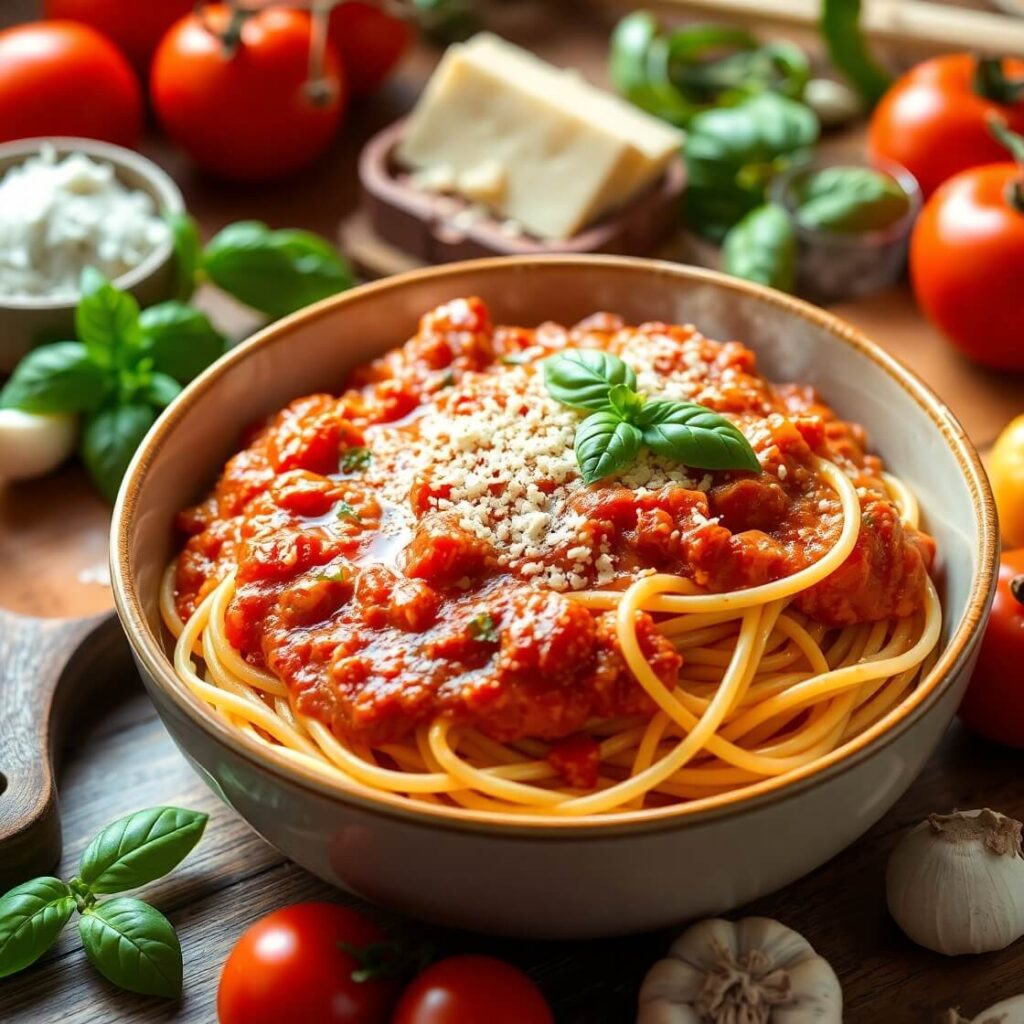
To get the absolute best from your homemade spaghetti sauce, here are a few tips I’ve learned through experience:
- Use quality canned tomatoes. San Marzano tomatoes are preferred for their natural sweetness and low acidity. If you can find them, your sauce will taste richer and more authentic.
- Slow and low simmering is key. While the sauce can be made relatively quickly, letting it simmer gently for at least 30 minutes allows the flavors to marry beautifully and the sauce to thicken naturally.
- Don’t skip fresh basil at the end. Adding fresh herbs right before serving preserves their vibrant aroma and brightness, which can be lost if cooked too long.
- Balance acidity carefully. Tomatoes vary in acidity depending on brand and type. Taste your sauce during cooking and add a small pinch of sugar or a splash of balsamic vinegar if needed to balance flavors.
- Sauté onions and garlic slowly. Avoid browning or burning them to prevent bitterness. A gentle translucent sauté releases sweetness that enhances the sauce’s base.
- For extra depth, try roasting your tomatoes. This adds smoky complexity if you want to experiment beyond the classic.
With these tricks, you can consistently craft a sauce that tastes fresh, flavorful, and homemade.
Common Mistakes to Avoid
Making spaghetti sauce seems straightforward, but a few common mistakes can impact the final flavor and texture:
- Burning the garlic: Garlic cooks quickly and can become bitter if overcooked. Add it after onions are soft and keep stirring.
- Using low-quality tomatoes: Avoid generic canned tomatoes as they can be watery or bland, affecting your sauce’s richness.
- Not simmering long enough: Under-simmering results in a watery, one-dimensional sauce. Patience pays off here.
- Over-seasoning too early: Herbs and salt should be added gradually and adjusted towards the end to avoid overpowering the natural tomato flavor.
- Skipping fresh herbs: Fresh basil at the end really lifts the sauce and adds freshness many miss.
Avoid these pitfalls, and you’ll be rewarded with a perfectly balanced and rich sauce every time.
How to Store It
Homemade spaghetti sauce stores beautifully, making it perfect for batch cooking. Allow the sauce to cool completely before transferring to airtight containers or jars.
You can refrigerate it safely for up to 5 days. For longer storage, freeze the sauce in portions—muffin tins work great for individual servings. Once frozen solid, transfer portions to freezer bags and label them with the date.
When reheating, thaw in the fridge overnight and warm gently on the stovetop, stirring occasionally to bring back that fresh, vibrant flavor. Avoid microwaving as it can unevenly heat the sauce.
Freezing not only extends the sauce’s life but also helps deepen the flavors even more over time.
FAQ
Can I use fresh tomatoes instead of canned?
Yes, fresh ripe plum tomatoes work well. Peel and crush them before cooking. Fresh tomatoes give a brighter, more delicate flavor but may require longer simmering.
Is this sauce suitable for freezing?
Absolutely! This sauce freezes very well. Portion into containers or freezer bags and thaw before use.
Can I make this sauce vegan?
Yes, the recipe is naturally vegan if you skip cheese garnishes. It contains only plant-based ingredients.
What pasta types pair best with this sauce?
Traditional spaghetti, linguine, or rigatoni are excellent choices. The sauce clings nicely to long or tubular pasta shapes.
Can I add meat to this sauce?
Yes! Browned ground beef, Italian sausage, or meatballs can be added for a heartier sauce.

Homemade Spaghetti Sauce
- Total Time: 55 minutes
- Yield: 4 1x
- Diet: Vegan
Description
A classic Italian-style sauce made from scratch with ripe tomatoes, fragrant herbs, and simple pantry staples. This sauce is richly flavorful yet light and fresh, perfect for pasta dishes or as a base for your favorite recipes. With minimal ingredients and an easy-to-follow method, it delivers that homemade goodness without the hassle or additives. The slow simmer brings out a natural sweetness and depth, making it a family favorite any night of the week.
Ingredients
- 2 tbsp extra virgin olive oil
- 1 medium onion, finely chopped
- 3–4 garlic cloves, minced
- 28 oz can whole peeled San Marzano tomatoes
- 1 tsp dried basil
- 1 tsp dried oregano
- 1 tsp dried thyme
- Salt and black pepper, to taste
- 1 tsp sugar (optional)
- ¼ cup red wine or balsamic vinegar (optional)
- Fresh basil leaves for garnish
Instructions
- Heat olive oil in a saucepan over medium heat.
- Sauté onions until soft and translucent.
- Add garlic and cook until fragrant.
- Crush and add canned tomatoes, stirring to combine.
- Stir in dried herbs, salt, pepper, and sugar.
- Add wine or vinegar if using.
- Bring to a simmer, reduce heat to low, cover partially, and simmer for 30-45 minutes, stirring occasionally.
- Adjust seasoning and stir in fresh basil before serving.
Notes
- Use San Marzano tomatoes for authentic flavor.
- Simmer longer for thicker sauce.
- Add fresh herbs last to maintain brightness.
- Adjust acidity with sugar or vinegar as needed.
- Prep Time: 15 minutes
- Cook Time: 40 minutes
- Category: Sauce / Pasta Sauce
- Method: Stovetop Simmering
- Cuisine: Italian
Nutrition
- Serving Size: 4
- Calories: 120
- Sugar: 6g
- Sodium: 250mg
- Fat: 7g
- Saturated Fat: 1g
- Unsaturated Fat: 6g
- Trans Fat: 0g
- Carbohydrates: 14g
- Fiber: 3g
- Protein: 2g
- Cholesterol: 0mg

